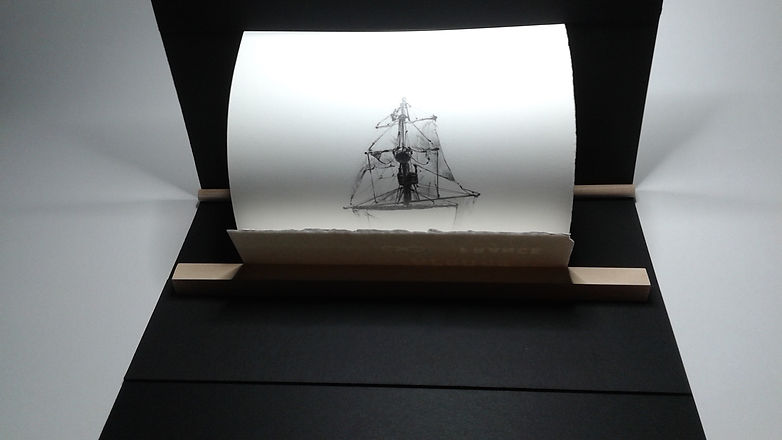THE PHYSICS PROJECT
INTRODUCTION
The Physics Project contains a series of small-scale, two and three-dimensional objects in flat, cut or folded paper incorporating drawing materials, gouache, watercolor and collage as well as off-the-shelf merchandise. As opposed to scientific illustrations, technical drawings/diagrams, or science-fiction renderings, The Physics Project is an assembly of musings, visual meditations on theories and phenomena from the sphere of physics.
PROLOGUE
The things by which we live are but the brief flashes of insect wings in a clouded sunlight.
--Unknown
What in heaven's name was the real essence of this beauty? Was it the precision of nature with its physical laws, or was it nature's mercilessness, ceaselessly resisting man's understanding?
--Kobo Abe, M.D., physician, author, playwright, scenarist, photographer, and inventor; from "The Woman in the Dunes," a novel; 1962 (adapted for film, 1964; directed by Hiroshi Teshigahara).
Dramatic developments in cosmological findings and thought have led some of the world's premier physicists to propose that our universe is only one of an enormous number of universes, with wildly varying properties, and that some of the most basic features of our particular universe are mere accidents- random throws of the cosmic dice...It is perhaps impossible to say how far apart different universes may be, or whether they exist simultaneously in time. But, as predicted by new theories in physics, the many different universes almost certainly have very different properties. Some may have stars and galaxies like ours. Some may not. Some may be finite in size. Some may be infinite. Some may have five dimensions, or seventeen. Physicists call the totality of universes the 'multiverse'.
--Alan P. Lightman, Ph.D., physicist, author, essayist, and professor of humanities; from "The Accidental Universe," 2013 (originally published in Harper's, December, 2012).

study for the physics project: earth is a sphere (after a Greek argument ca. 400-200 B.C.E.). 2016. Graphite on cut and folded Arches, black board, wood, 6 1/2 x 11 x 8 1/2 in

detail

study for the physics project: black hole. 2016. Graphite on Arches (size variable)

study for the physics project: black hole 2 (interior wall). 2016. Gouache, color pencil, watercolor pencil on die-cut chipboard; two panels, each panel 8 x 5 1/4 in (Partial view)

detail

study for the physics project: multiverse. 2016. Graphite on cut and folded card stock, found form (origamic architecture by Masahiro Chitani), black board; 3 7/8 x 8 1/2 x 10 in

detail

study for the physics project: expanding universe. 2016. Color-copied found image, watercolor & ink on Arches, painted wood shadow box w/glass; 10 x 10 x 4 in

detail

study for the physics project: multiverse 2. 2016. Found postcards, electronic components, thread, painted wood shadowbox; overall 9 x 20 x 1 1/2 in

detail

study for the physics project: dark matter ("the invisible elephant in the room") (homage to Alan P. Lightman, Ph.D.). 2016. Graphite, color pencil, ink on Arches, 5 3/16 x 9 5/8 in

detail

study for the physics project: spiral galaxy (materializing). 2017. Graphite, color pencil, gouache, watercolor, collage on Arches; 10 x 14 in

detail

study for the physics project: glove pursued by speed of light. 2016-2017. Mixed-media; 1 1/2 x 14 1/8 x 4 1/8 in

detail

study for the physics project: collapsed star. 2017. Graphite, color pencil on manipulated Arches; height, width, depth variable (roughly 10 1/4 x 14 1/8 x 2 5/16 in)

detail

study for the physics project: galaxy manifestation. 2017. Graphite on cut and torn Arches; 12 x 11 in

detail

study for the physics project: after the initial condition. 2017. Graphite and color pencil on cut and folded Arches; height variable x 10 1/4 in

detail

study for the physics project: CBR (cosmic background radiation a.k.a., cosmic background radiation noise). 2017. Ink, gouache, card stock, wood, wire; 4 1/4 x 6 1/2 in x depth, variable

detail
